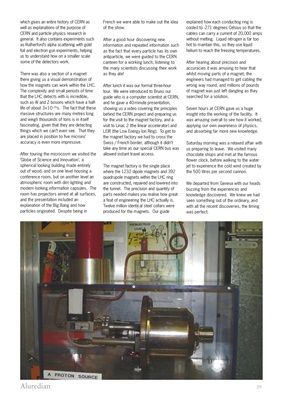
which gives an entire history of CERN as
well as explanations of the purpose of
CERN and particle physics research in
general. It also contains experiments such
as Rutherford's alpha scattering with gold
foil and electron gun experiments, helping
us to understand how on a smaller scale
some of the detectors work.
There was also a section of a magnet
there giving us a visual demonstration of
how the magnets can work within the LHC.
The complexity and small periods of time
that the LHC detects with is incredible,
such as W and Z bosons which have a halflife
of about 3×10−25s. The fact that these
massive structures are many metres long
and weigh thousands of tons is in itself
fascinating, given that they are detecting
things which we can't even see. That they
are placed in position to five microns'
accuracy is even more impressive.
After touring the microcosm we visited the
'Globe of Science and Innovation', a
spherical looking building made entirely
out of wood, and on one level housing a
conference room, but on another level an
atmospheric room with dim lighting and
modern looking information capsules. The
room has projectors aimed at all surfaces,
and the presentation included an
explanation of the Big Bang and how
particles originated. Despite being in
French we were able to make out the idea
of the show.
After a good hour discovering new
information and repeated information such
as the fact that every particle has its own
antiparticle, we were guided to the CERN
canteen for a working lunch, listening to
the many scientists discussing their work
as they ate!
After lunch it was our formal three-hour
tour. We were introduced to Bruno our
guide who is a computer scientist at CERN,
and he gave a 40-minute presentation,
showing us a video covering the principles
behind the CERN project and preparing us
for the visit to the magnet factory, and a
visit to Linac 2 (the linear accelerator) and
LEIR (the Low Energy Ion Ring). To get to
the magnet factory we had to cross the
Swiss / French border, although it didn't
take any time as our special CERN bus was
allowed instant travel access.
The magnet factory is the single place
where the 1232 dipole magnets and 392
quadrupole magnets within the LHC ring
are constructed, repaired and lowered into
the tunnel. The precision and quantity of
parts needed makes you realise how great
a feat of engineering the LHC actually is.
Twelve million identical steel collars were
produced for the magnets. Our guide
explained how each conducting ring is
cooled to -271 degrees Celsius so that the
cables can carry a current of 20,000 amps
without melting. Liquid nitrogen is far too
hot to maintain this, so they use liquid
helium to reach the freezing temperatures.
After hearing about precision and
accuracies it was amusing to hear that
whilst moving parts of a magnet, the
engineers had managed to get cabling the
wrong way round, and millions of pounds
of magnet was just left dangling as they
searched for a solution.
Seven hours at CERN gave us a huge
insight into the working of the facility. It
was amazing overall to see how it worked,
applying our own awareness of physics,
and absorbing far more new knowledge.
Saturday morning was a relaxed affair with
us preparing to leave. We visited many
chocolate shops and met at the famous
flower clock, before walking to the water
jet to experience the cold wind created by
the 500 litres per second cannon.
We departed from Geneva with our heads
buzzing from the experiences and
knowledge discovered. We knew we had
seen something out of the ordinary, and
with all the recent discoveries, the timing
was perfect.
Aluredian 29